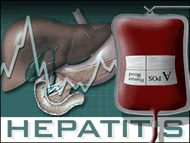 Edward
Murphy from the University of California San Francisco and colleagues
with the Retrovirus Epidemiology Donor Study performed a large
cross-sectional study of blood donors at 6 U.S. blood centers
during 2006-2007.
Edward
Murphy from the University of California San Francisco and colleagues
with the Retrovirus Epidemiology Donor Study performed a large
cross-sectional study of blood donors at 6 U.S. blood centers
during 2006-2007.
During 1992-1993, the prevalence of anti-HCV antibodies detected
among U.S. blood donors was 0.36%, but more recent data on the
prevalence of HCV antibodies and HCV RNA (genetic material)
are lacking, the study authors noted as background.
The investigators measured HCV antibodies using an enzyme-linked
immunosorbent assay (ELISA) followed by immunoblot testing.
HCV RNA was measured using nucleic acid testing.
Results
 |
Out
of 959,281 blood donors tested, HCV antibodies were detected
in 695 people, for an overall prevalence of 0.072%. |
 |
Among
people positive for HCV antibodies, 516 (74%) also had detectable
HCV RNA, while the remainder were HCV RNA negative. |
 |
Compared
with prevalence during 1992-1993, prevalence during 2006-2007
was lower and peaked in older age groups. |
 |
Obese
individuals (body mass index > 30) were less likely to
be HCV antibody positive (adjusted odds ratio [aOR] 0.6)
and more likely to have undetectable HCV RNA (aOR 2.4). |
 |
Among
women, HCV antibody prevalence was association with higher
gravidity, or greater number of pregnancies (aOR 3.2 for
5 vs 0 pregnancies). |
 |
About
1 in 1000 women with 5 or more children had HCV antibodies,
compared with about 1 in 3300 women with no pregnancies. |
 |
People
with more than a high school education were more likely
to have undetectable HCV RNA (aOR 1.6). |
 |
African-Americans
had a lower likelihood of having undetectable HCV RNA (aOR
0.4). |
"Decreasing
HCV prevalence is most likely attributable to culling of seropositive
donors and a birth cohort effect," the researchers concluded.
That is, donors with detectable HCV antibodies likely have been
excluded from the blood donor pool.
With regard to age, many "baby boomers" now in their
50s and 60s were infected -- for example, through experimenting
with injection drug use -- during the 1960s and '70s, before
HCV was discovered. Members of this birth cohort have now reached
an age at which HCV-related liver damage may have progressed
to an advanced stage.
"We found new associations between anti-HCV prevalence
and gravidity and obesity," the authors added. "Recently
discovered genetic factors may underlie differences in HCV RNA
clearance in black donors."
University of California, San Francisco, CA; Blood Systems
Research Institute, San Francisco, CA; Westat, Rockville, MD;
American Red Cross Blood Services, New England Division, Farmington,
CT; Emory University, Atlanta, GA; American Red Cross Blood
Services, Southern Region, Atlanta, GA; Hoxworth Blood Center,
Cincinnati, OH; Institute for Transfusion Medicine, Pittsburgh,
PA; Blood Center of Wisconsin, Milwaukee, WI.
8/6/10
Reference
EL
Murphy, J Fang, Y Tu, and others (Retrovirus Epidemiology Donor
Study). Hepatitis C Virus Prevalence and Clearance among US
Blood Donors, 2006-2007: Associations with Birth Cohort, Multiple
Pregnancies, and Body Mass Index. Journal of Infectious Diseases
(Abstract).
July 9, 2010 (Epub ahead of print).
